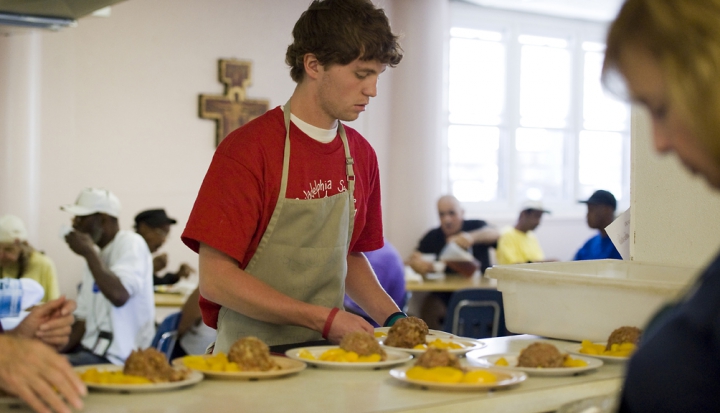Social ministry is the job of the entire parish community. What are we waiting for?
As the implications of the gospel, baptism, Vatican II, and, specifically, the recognition of the responsibilities that come with being seized by God’s love and Spirit unfold, the American Catholic parish has slowly but surely moved in the direction of being more deliberate about beckoning and organizing its members to engage in the needs of the world, both local and faraway. It’s called parish social ministry. Admittedly, it’s a work in progress.
Those who have been doing the work of charity and justice for many decades have alternated between feelings of impatience and hope. Under the sway of Pope Francis’ remarkable enthusiasm and witness, it is easier to feel hopeful and to expect the numbers of parishioners engaged in the effort to address human cries to grow.
While it’s tempting to offer the quick advice, “Do anything!”—to emphasize that social ministry is not optional and it is urgent—this will simply not suffice. In fact, when it comes to engaging with our sisters and brothers who suffer, it is very important that we not only do something but that we do it with as much care, thought, prayer, and expertise as possible. This is not said to discourage initiative or generosity, but as Robert Lupton illustrates in his book, Toxic Charity (HarperOne), it has too often been the case that, even with a good heart, it is easy to do much damage if we engage with inadequate information or poor judgment.
Here, then, are four practices which can help make parish social ministry vibrant and effective.
1. All for one
Communities of Salt and Light, the U.S. bishops’ 1993 document on parish social ministry, makes the case that social mission is not the responsibility of a handful of parishioners who often feel isolated, misunderstood, or even eyed suspiciously by the rest of the parish. The work of social ministry—compassion made real in direct service, advocacy, community organizing, and sacrificial giving—is the work of the parish, the entire parish.
To that end, everything in the parish must be embedded with the message of mission: preaching, teaching, adult education, youth ministry, children’s catechesis, everything. As a religious educator, I am all too aware of how adult formation has often considered Catholic social teaching and social mission to be a kind of extracurricular afterthought.
In other words, what happens (or not) in the parish will determine what happens (or not) beyond the parish. If we prepare people for the works of charity and justice in all that we do, then we can expect an abundant harvest of workers. Not only will we see that our action is enhanced by being rooted in faith and prayer, but we will also see our faith and prayer deepened by the insights and experience of engaged discipleship.
2. There’s a large body of work to be done
It’s a big world and there are a lot of needs—and a lot of different kinds of needs. Any parish social ministry worth its salt is going to prepare for and encourage lots of different kinds of responses to the different needs.
In 1 Corinthians Paul writes that the foot is not the hand and the eye is not the ear, but all are important to the body. To make the clear application, those in our parishes who work on issues related to human trafficking, for example, should celebrate—not diminish—the work of those dedicated to issues related to mental illness. Those focused on environmental care should celebrate—not diminish—the work of those focused on reducing abortions. Those who work on domestic issues in partnership with Catholic Charities should celebrate—not diminish—those who work on international issues in partnership with Catholic Relief Services. Charisms are not ranked. Compassion has many faces. The world has many troubles.
Thus, parishes are wise to invite many ministries out of respect for the varying charisms in the community, with the understanding that each ministry should be scaled appropriately, with adequate volunteers and funding, if necessary. Yes, there probably can be too many ministries, if the consequence is that they suffer from a lack of participation and resulting ineffectiveness. More often the problem is that there are not nearly enough social ministry opportunities, so that the great potential in many parishes goes untapped.
3. Relationship, charity, justice
The work of charity requires that we make time to be with those who struggle. The heart of charity is not collecting canned goods; the heart of charity is relationship.
So we must find ways to invite our parishioners into the lives of those who are experiencing hardship. It is from the vulnerability of shared lives that we can find ways, in dialogue and cooperation, to address unmet needs. To this end, parishes might want to link with the work of Catholic Charities or the Society of St. Vincent de Paul, for example.
Furthermore, to be effective we must consider both charity and justice. An excellent educational resource, Two Feet of Love in Action, can be found on the website of the U.S. bishops (usccb.org). This important tool describes two distinct but complementary ways to respond to God’s love: social justice activity (addressing structural causes of problems) and charitable works (short-term, emergency assistance).
While the parish is addressing immediate needs with soup kitchens, food pantries, and clothing closets, it is also called to engage in the work of evangelizing systems—the social change work that comes with legislative advocacy and community organizing. Many dioceses have a legislative advocacy network connected with their state’s Catholic Conference, and Bread for the World provides parishes with an annual Offering of Letters to help parishioners write to Congress on hunger-related issues. Many dioceses also are involved with faith-based organizing efforts that receive funding from the Catholic Campaign for Human Development.
We need to walk with both feet of social action in order to make the dream of God’s justice real in the world.
4. Run in packs
Parish social ministry is best done in community. The hard work of connecting with human struggle and its many causes, complexities, inconveniences, and sadnesses can only be sustained in community. The gospel is not for solo artists.
Together we can do things we could never do on our own. When we hold each other in prayer, love, support, and encouragement, there is much we can bear and even celebrate that could never be born or celebrated if we dared to set out on our own.
The rise and growth of small faith communities in the United States has yet to reach fulfillment since many such groups have remained comfortably situated in living rooms. On the other hand, the small faith community that holds social mission as a core commitment can be a potent expression of faith and action. Having a community to pray with, learn with, and act with not only has more capacity and wisdom to draw from, it is the container and catalyst for joy.
Dare to dream
One day, perhaps in this magazine, we will read about a parish that has organized itself around the crescendo vision of Matthew 25. It will be a parish that has anchored everything it does in the hope and intention of forming and sending its members to feed the hungry and clothe the naked and do justice. It will be a parish that organizes all of its members into mission teams. It will be a parish that sponsors its own Catholic Worker House. It will be a parish that has dozens of people doing home visits for St. Vincent de Paul and legislative visits at their congressperson’s office. It will be a parish that will have started a half dozen nonprofit organizations that address needs that were not being met. It will have its own economic development committee, will host workshops on peacemaking and nonviolence, and will have a youth ministry that looks, appropriately, a lot like the Jesuit Volunteer Corps. It will have many stories of generosity and sacrifice and heartache and joy to tell. And it will all be celebrated around a table every Sunday. Let’s get started.
This article appeared in the March 2014 issue of U.S. Catholic (Vol. 79, No. 3, pages 30-31).
Want to read about more ways to help your parish become a thriving and engaging community? Here is our Special Section: Best practices for parishes.
Image: Flickr photo cc by SJU Undergraduate Admissions
















Add comment